What are voltage stabilizers?
To date low voltage - the problem is very relevant and it is best to solve it in one way - to purchase a voltage stabilizer (CH), which will protect all the equipment in the house from failure. To choose the right device, you first need to deal with its varieties, as well as the principle of operation of each embodiment. Next, we will consider the pros and cons of the main types of voltage stabilizers for the home, namely: relay, electronic, electromechanical, ferroresonance and inverter.
Relay
Relay or, as they are also called step stabilizers, are considered the most popular for use in the house and in the country. This is due to the low cost of devices, as well as high accuracy regulation. The principle of operation of the relay model is to switch the windings on the transformer using a power relay, which operates in automatic mode. The main disadvantages of this type of CH are considered to be a stepwise voltage change (not smooth), a sinusoid distortion and limited output power. However, judging by the reviews on the Internet, most buyers are satisfied with the devices, as the price is several times less than more advanced models. The representative of the relay-type stabilizers for the home is Resanta ASN-5000N / 1-Ts, which you can see in the picture below:
Electronic
Electronic HF can be triac and thyristor. The principle of operation of the first is based on switching between the autotransformer windings with the help of a triac, due to which this type of voltage regulator has a high efficiency and a quick response to operation. In addition, triac models work silently, which is another plus of the CH of this variety. As for thyristor, they also have proven themselves well and are popular in everyday life. The only drawback of electronic type devices is the higher cost.
Electromechanical
Electromechanical SNs are also commonly called servo-motors or servo-motors. Such stabilizers work due to the movement of the carbon electrode along the windings of the autotransformer due to the electric drive. Electromechanical devices can also be used to protect household appliances in a house, apartment and cottage. The advantage of this type of stabilizers is low cost, stepless voltage regulation and compact size. Of the minuses, one can distinguish increased noise during operation and low speed.
Ferroresonant
The principle of operation of such SNs is based on the effect of voltage ferroresonance in a capacitor-transformer circuit. This type of protective device is not very popular among consumers due to noise in operation, large dimensions (and, consequently, considerable weight), as well as the inability to work during overloads.The advantages of ferroresonant stabilizers are a long service life, accuracy of adjustment and the ability to work in rooms with high humidity / temperature.
Inverter
The most expensive type of voltage stabilizers, which are used not only in the house, but also in production. The principle of operation of inverter models is to convert alternating current into direct current (at the input) and back to alternating current (at the output) thanks to the microcontroller and the crystal oscillator. The undoubted advantage of inverter SN with double conversion is a wide input voltage range (from 115 to 290 Volts), as well as high regulation speed, quiet operation, compact size and the presence of additional functions. As for the latter, inverter-type CHs can additionally protect household appliances from overvoltage, as well as other interference from an external electrical network. The main disadvantage of devices is the highest price.
You can learn more about varieties of CH in the video below:
So we examined the main types of voltage stabilizers. I would also like to note that there are such types of HF as single-phase and three-phase. In this case, you should choose a model, depending on what voltage in your network is 220 or 380 Volts.

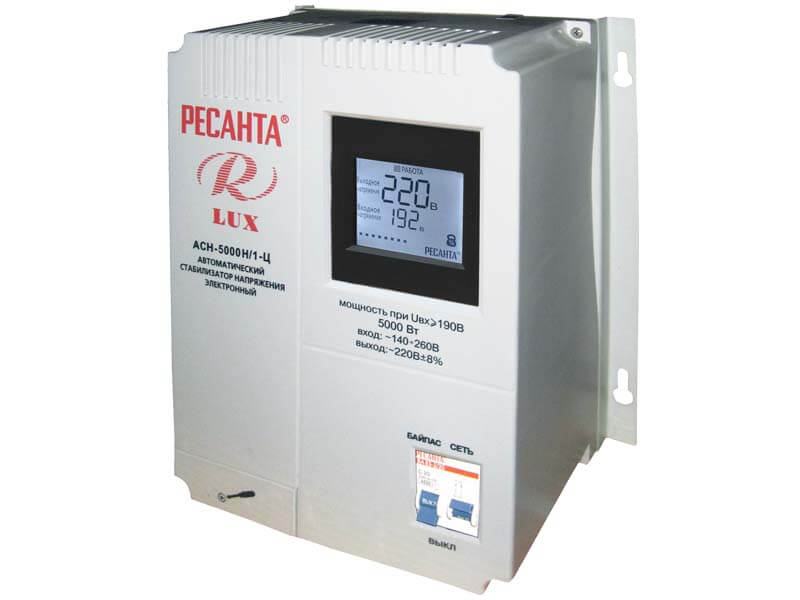
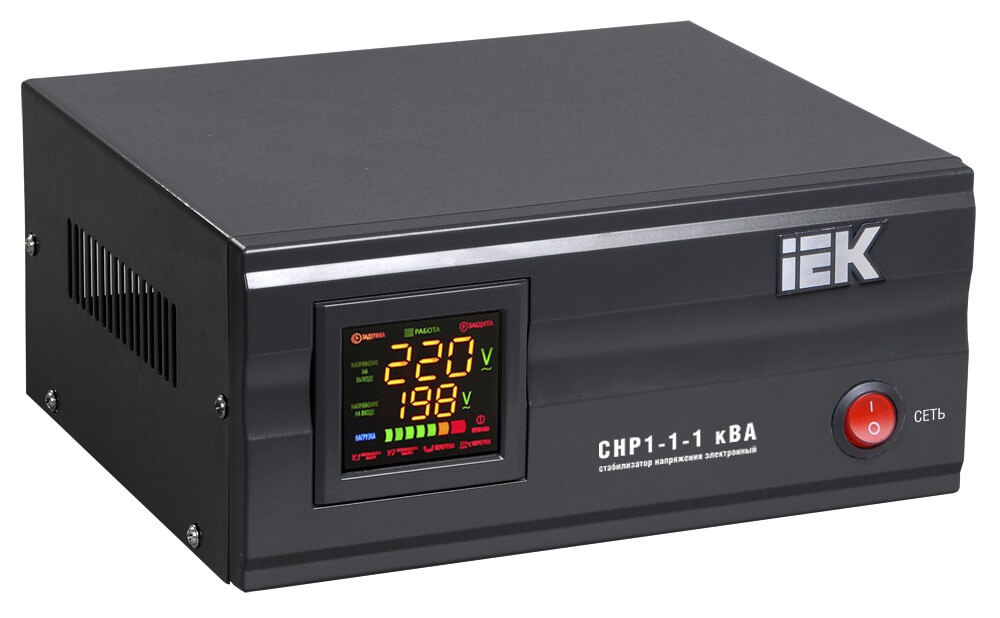
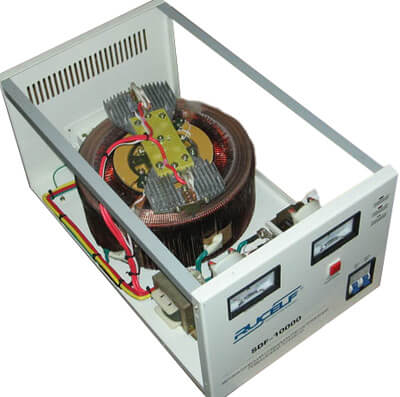
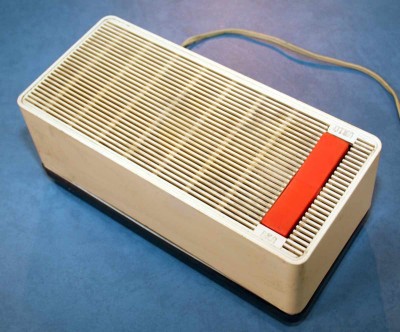
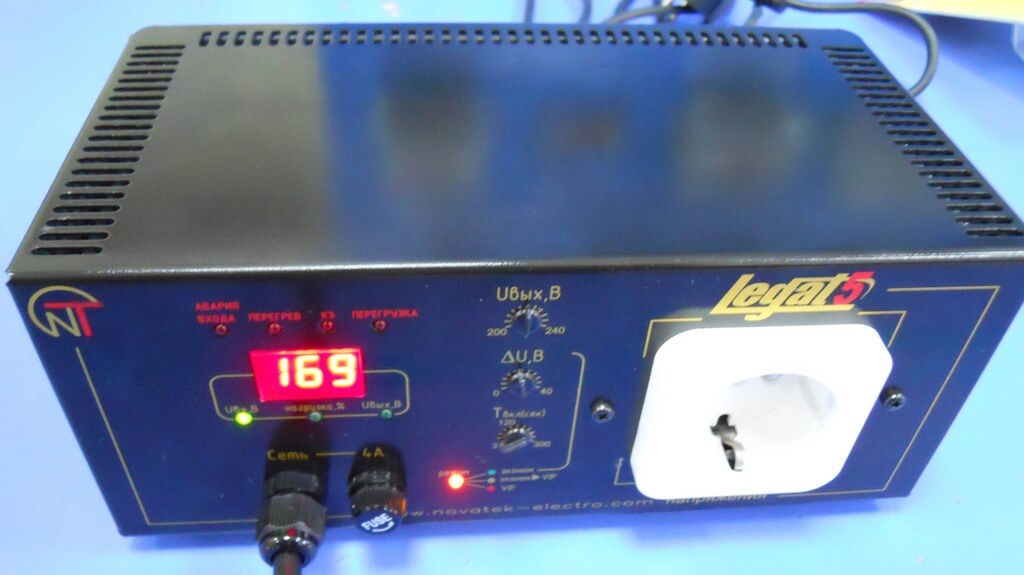


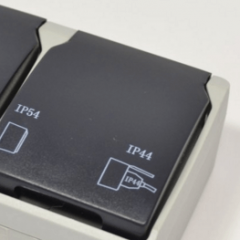
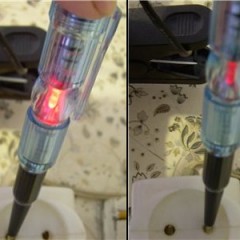


just in case of emergency I want to put a stabilizer on the whole apartment. the total power of all consumers is 15 kW, with problems with overload, blackouts, etc. did not have. Counter at 60A and RCD at 50A. If you focus on power, you need to take a stub at 30kVA its max. in. the current will be about 150A! Does it make sense when choosing a stub to focus on 15kW or better at 50-60A?
Hello, the thing is that the work of all consumers at the same time is unlikely. You need to make a list of all powerful consumers and the time of their work, also in groups to combine which are included and work at the same time. Most likely the load will be much less than you think. You can also control the current on the counter, for a while, build a graph. By the formula we find out the power consumption. Voltage is multiplied by current.
15000=68*220
15000 is 15kW
68 amp consumption
220 volts in the network
Thank you for the answer, but I would like to understand if I understand correctly that in my case, even if I put the MV at 30 kVA with I input. max. 150 And I can load it (turn on electronic devices) until the current that I consume from the network exceeds 50 A (the current of my RCD) and then the current protection trips to the RCD and it turns off the entire apartment. In this case, the current reserve of the SN will be another 100 A. In other words, with the parameters of the electronic devices that I have, it is enough for me to put the MV with I input.max. 50 A e.g. Powerman AVS 8000 P.
It makes no sense to set more than 15 kW, in addition, there are consumption standards and it is unlikely that they will consume more than what is needed, besides, you are not aware of the wiring condition at the input, and the fact that you have installed a 50 amp machine is not a guarantee that you will get so much, and the cable will withstand.
Firstly, I wonder where you found the RCD to 50A, and secondly, the RCD will not turn off the current once (from the word at all)! Since the principle of its operation is the leakage of the differential current, and not tripping on overload or short circuit. According to the selection, they told you right away that you can use 15KV of electricity at a time, the only thing that you forgot is reactive current or the so-called inrush current (wherever there are electromagnetic coils, motors,) therefore the power of all stabilizers is indicated in reactive volt-amperes, so they should also be considered when choosing a stabilizer. Sincerely, seller - consultant ABC-Electro
Good morning! Can you please tell me, but does the voltage stabilizer connect before a fire protection RCD or after? And if before, then what if the fire protection RCD is installed in the metering board? Thanks in advance!!!